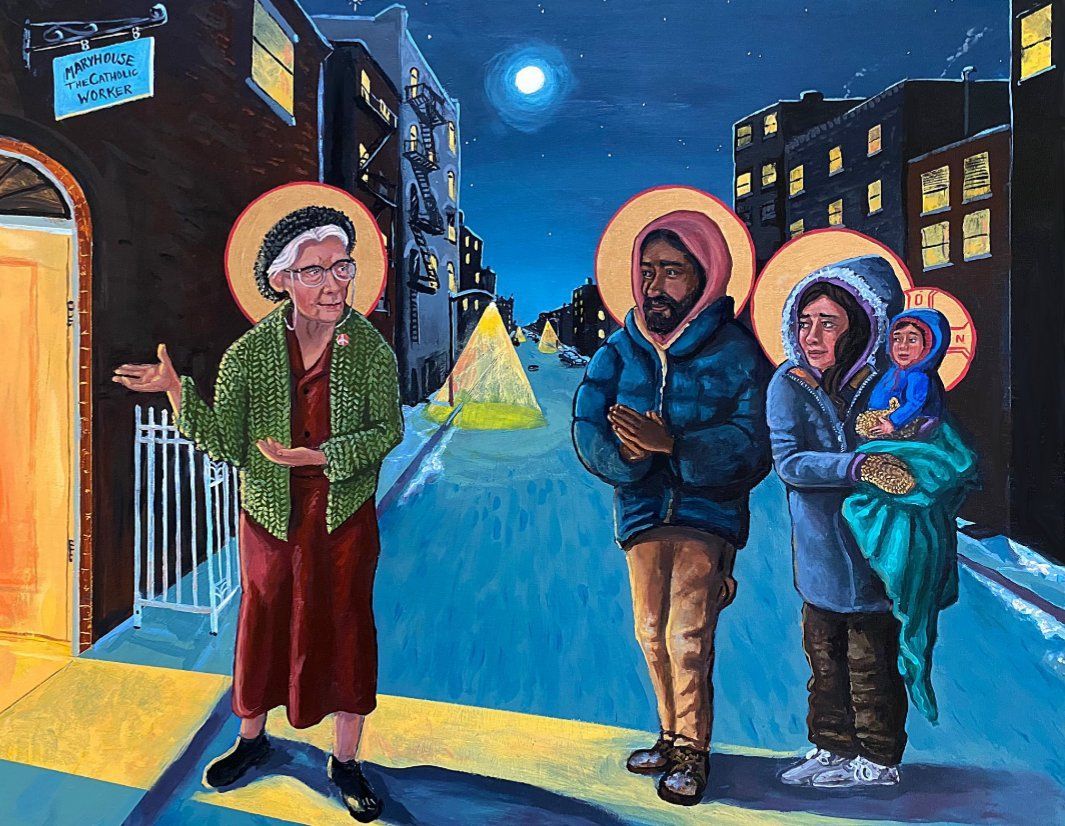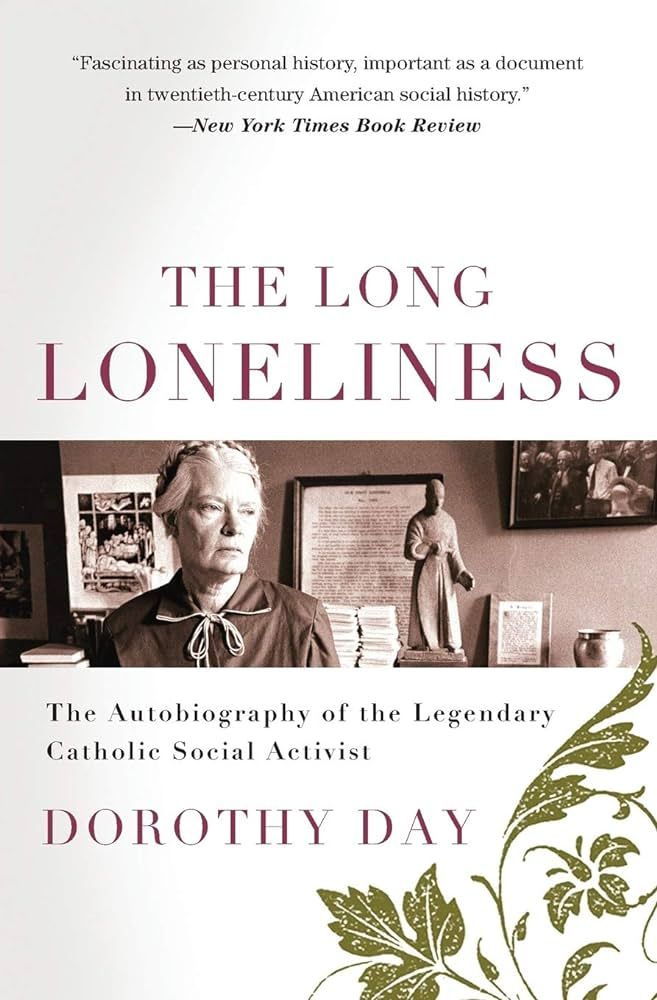PHONE
555-555-5555
ADDRESS
The Dorothy Day Guild
4513 Manhattan College Parkway
Bronx, NY 10471
Happy New Year!
Dear friends,
Merry Christmas from all of us at the Dorothy Day Guild! We hope that all of you were able to enjoy some rest and refreshment as Advent concluded and we began the celebration of the Christmas season. Every year, Kelly Latimore’s beautiful image of Dorothy welcoming the Holy Family to Maryhouse captures for us the spirit of hospitality, vulnerability, and peace that characterizes this time of year. Many thanks to the artists and musicians who have brought such beauty and variety to our homes and our liturgies over the past few weeks!
January is, of course, a time of looking both forward and backwards, at where we have been, and where we are going. This past year has been so full! Keep an eye out for our January issue of “In Our Time” for our Guild year-end report for 2023. Our steering committee also met on December 30th to plan the next year of Guild events and activities. We’re excited to share more with you soon as we announce upcoming events and opportunities to learn more about Dorothy’s life and work and to share her legacy with others!
Upcoming Events:
Is your New Year’s resolution to read more good books in 2024? We had such a good time last fall with our Thérèse reading group that we’ve decided to offer another Dorothy book club for the spring semester! Historian and longtime friend of the Guild, Anne Klejment, has graciously agreed to host a Lenten book club where we will read Dorothy’s spiritual autobiography, The Long Loneliness, (available for purchase here) together over four sessions.
Our spring reading group will meet Sunday evenings at 8pm Eastern/7pm Central, beginning on March 3rd, and continuing March 10th, March 17th, and finishing on Palm Sunday, March 24th. Sign up using
this form to receive the reading schedule and additional materials. Anne is the author of a number of academic studies on the Catholic Worker movement and on Dorothy’s influence on American Catholicism, and we’re so excited for her to bring her expertise to this classic text!
We also received news that Kristi Pfister’s installation Radical Action: Tracing Dorothy Day, has been extended at Manhattan College and will remain on display through March 24th, 2024!
Recommendations for January:
Dorothy continues to inspire fresh reflections on moral theology, political theory, and ecclesial history more than forty years after her death. In the enormous outpouring of articles that came out in November, we missed this piece from author Kathryn Jean Lopez linking Dorothy with her fellow New Yorker and convert to Catholicism, St. Elizabeth Ann Seton through their shared love of the sacraments and their maternity. We’re excited to share this piece with you in honor of St. Elizabeth’s feast day, which takes place this week on January 4th! Our co-chair, Dr. Kevin Ahern has said many times how badly the Church needs more saints who have changed diapers; it’s perhaps at Christmas that we are most ready to see the holiness hidden in the constant labor of tending to small children. For those of you who have spent long days and nights over the past few weeks cooking, cleaning, and making the holidays special for your families, know that there are saints who see and understand what an enormous gift you have offered. Both Dorothy and St. Elizabeth understood the challenges of parenting without a spouse, but beyond raising their own children, both these holy women extended that love and compassion to the poorest and most marginalized in New York City, Maryland, and beyond as the mothers of movements in the Sisters of Charity and the Catholic Worker.
Speaking of New Yorkers, Dorothy, Mother Seton, and Venerable Pierre Toussaint are all featured in a new graphic novel-style history of the Archdiocese of New York, entitled
Building the Kingdom. The book tells the story of the Catholic Church in New York through the narratives of the holy men and women whose vocations to prayer and service began or flowered in this region. Dorothy’s story is spread across pages 36 and 37. The publisher isn’t currently selling individual copies, but if you would like to purchase a case of fourteen copies for your parish or school for classroom use or a fundraiser, you can use
this form to place your order.
The season of Advent is traditionally a time of reflection and spiritual preparation, but we certainly can continue growing throughout the Christmas season and into Ordinary Time! We appreciated David Carlson’s short piece published in Indiana’s Daily Journal on Dorothy’s witness to the primacy of conscience as our guide and teacher as we persevere in the lifelong task of discerning our vocation. “The only way to become the whole person that God has in mind for us, Day taught, is to make our decisions on the basis of consciences,” David writes. “God isn’t the voice of our egos, and God is not the voice of our fears. God’s voice is heard within the conscience — if we learn how to listen to it.”
In many wealthy societies, it can be so easy for us to get caught up in the conflicting demands on our time and attention at this time of year. Newsweek published a short opinion piece by Stephen Adubato which considers Dorothy’s economic philosophy as a mode of engagement with the world that is capable of transcending the neo-liberal project and our individualistic, atomistic attitudes towards our neighbors. If we truly want to enter into the Christmas spirit, Stephen suggests that
“We can start by looking at the example set by Dorothy Day and the followers, past and present, of her
Catholic Worker Movement, for whom the Christmas spirit is neither sentimental nor polemical. As their works of charity and hospitality demonstrate, the Christmas spirit is tangible, carnal—an "event" as concrete and dynamic as the first Christmas two millennia ago in Bethlehem. By entering the world as a helpless baby in a manger, surrounded by the support of a humble yet loving community, God revealed through the first Christmas that all human beings are designed to live in communion with him and with our neighbors.”
David Mills also published a seasonal reflection for National Catholic Register this weekend, "Dorothy Day on the True Joys of Christmas." David’s selections from the places in Dorothy’s diaries, books, and newspaper columns where she speaks of Christmas offers us an image of Dorothy’s devotion to the Incarnation of Jesus as a consistent touchpoint for her hospitality and activism and a theme to which she continually returned over the years in her spiritual writing.
Finally, Guild advisory committee member Martha Hennessy spoke with researcher and longtime friend of the Catholic Worker, Anna Blackman, in a joint interview exploring the Worker movement in the United States and Europe at the London Catholic Worker house on December 16th as part of their gathering celebrating the Worker’s 90th anniversary. Martha answered a few questions for Independent Catholic News in advance of the event to consider
how Dorothy’s legacy can continue to challenge us in the twenty-first century. Those of you who were present for the Mass for the Abolition of Nuclear Weapons on Dorothy’s anniversary of death back in November will be especially interested to hear how Martha thinks about the difference between her grandmother’s approach to nuclear abolition and the approach taken by the Berrigans and other Ploughshares activists, and what that means for the peace movement going forward. Dorothy Day, pray for us!
Prayer Requests:
In the past several weeks, a number of friends and members of the Guild have reached out to us requesting prayer through Dorothy’s intercession. Many of the needs mentioned have been for physical and psychological healing and for help discerning what God was asking of the petitioner. One of our friends, Donna from New York, has requested that we pray for her health, as she is dealing with some significant symptoms and is hoping to be able to avoid surgery. Brendan from Washington has also requested prayer for healing and support as he works to discern his vocation and serve those in need. Over the next month, please keep Donna, Brendan, and these other families and individuals close to you in prayer, perhaps taking a few minutes each evening to sit with an image of Dorothy and ask her to bring these requests for healing and for assistance living into vocations of service before God.
Prayer is one of the central purposes of our Guild. We have prayer cards available at no charge, which feature an image of Dorothy and a sample petitionary prayer that you can use to make these requests on behalf of our friends and members. If you would like to request prayer cards for yourself or a loved one, please
contact us, and please
reach out if there is a particular way we can be praying for you and your community.
A few words from Dorothy:
The liturgical season of Christmas continues through the feast of the Baptism of the Lord, which we’ll celebrate on January 8th this year (but if you want to continue celebrating until the feast of the Presentation of the Lord on February 2nd, we won’t tell anyone!), so we’d like to share one of Dorothy’s most famous Christmas reflections. You can read “Room for Christ,” originally published in the December 1945 issue of The Catholic Worker in full here
It is no use to say that we are born two thousand years too late to give room to Christ. Nor will those who live at the end of the world have been born too late. Christ is always with us, always asking for room in our hearts.
But now it is with the voice of our contemporaries that he speaks, with the eyes of store clerks, factory workers and children that he gazes; with the hands of office workers, slum dwellers and suburban housewives that he gives. It is with the feet of soldiers and tramps that he walks, and with the heart of anyone in need that he longs for shelter. And giving shelter or food to anyone who asks for it, or needs it, is giving it to Christ…
In Christ’s human life there were always a few who made up for the neglect of the crowd.
The shepherds did it, their hurrying to the crib atoned for the people who would flee from Christ.
The wise men did it; their journey across the world made up for those who refused to stir one hand’s breadth from the routine of their lives to go to Christ. Even the gifts that the wise men brought have in themselves an obscure recompense and atonement for what would follow later in this Child’s life. For they brought gold, the king’s emblem, to make up for the crown of thorns that He would wear; they offered incense, the symbol of praise, to make up for the mockery and the spitting; they gave Him myrrh, to heal and soothe, and He was wounded from head to foot and no one bathed his wounds. The women at the foot of the cross did it too, making up for the crowd who stood by and sneered.
We can do it too, exactly as they did. We are not born too late. We do it by seeing Christ and serving Christ in friends and strangers, in everyone we come in contact with.
Every time I read this piece, I’m reminded anew of the timeliness of the Incarnation. We can make room for Christ in our homes, in our hearts, and in our world today. We are not too late, nor do we have to wait for Christ to come again to offer Him our hospitality. Please join us in praying along with Pope Francis for the many families and individuals around the world who, like Mary and Joseph and their baby, are without adequate shelter, safety, and medical care this winter. Let’s especially pray through Dorothy’s intercession for peace in Palestine, the homeland of the Holy Family. We hope that in this Christmas season, you have found new ways to welcome Christ in friends and strangers, and that in turn, someone has offered warmth and hospitality to you.
In peace,
Dr. Casey Mullaney, on behalf of the Dorothy Day Guild
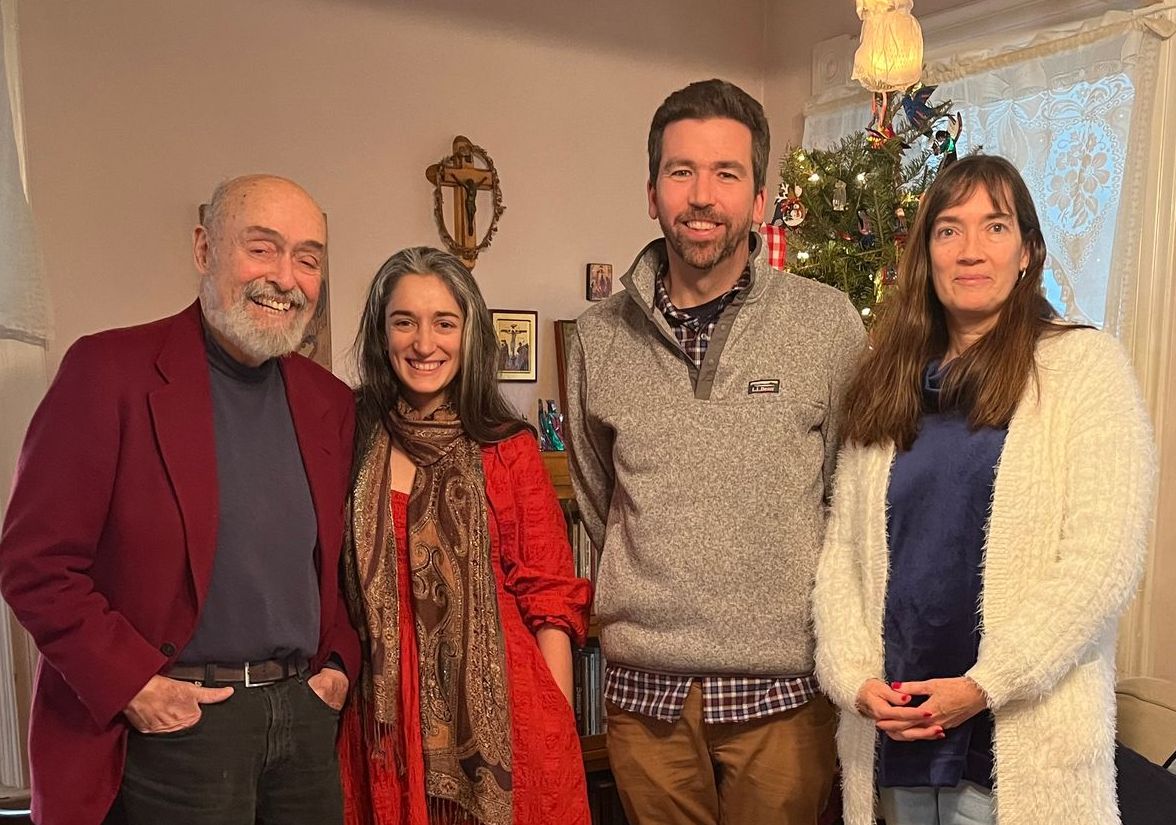

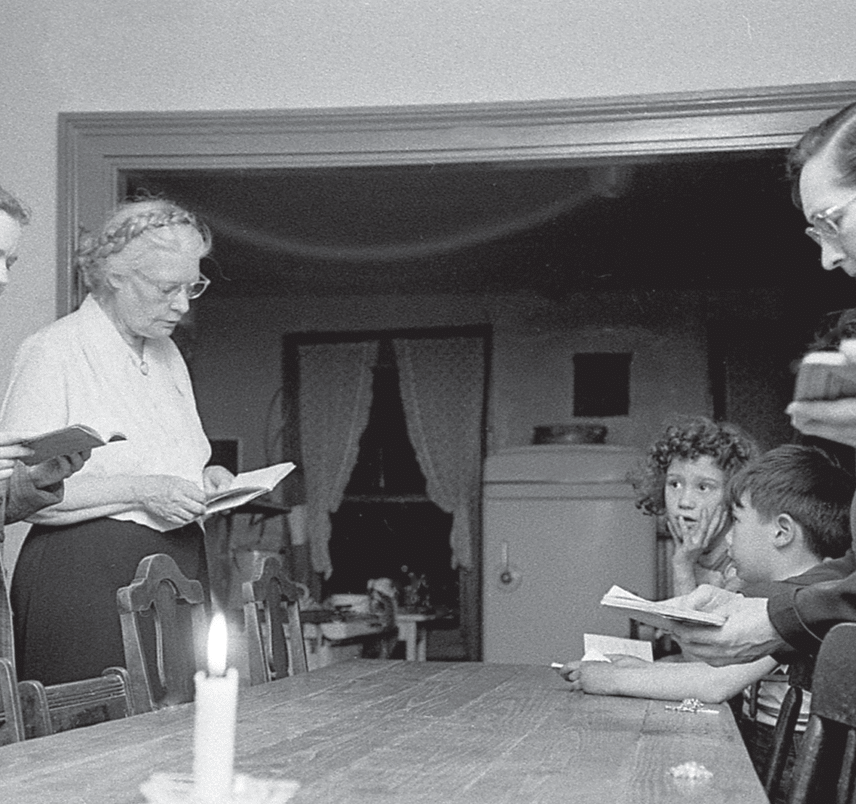
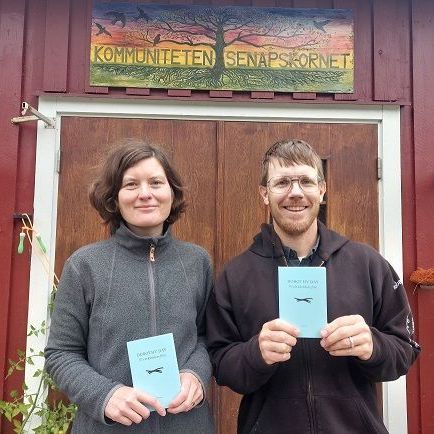
A Woman of Conscience, a Saint for Our Time
The Dorothy Day Guild supports and advances the cause for canonization of Dorothy Day, initiated by the Archdiocese of New York as a saint by the Roman Catholic Church, and promotes, for the benefit of all people interested in social justice, awareness of Dorothy Day, her writings, the Catholic Worker Movement she co-founded, and her life and witness to the Gospel.
QUICK LINKS
CONTACT INFO
ADDRESS
The Dorothy Day Guild
4513 Manhattan College Parkway
Bronx, NY 10471
© 2024 All Rights Reserved | Dorothy Day Guild | This site is powered by Neon One



